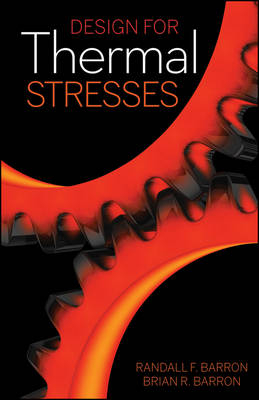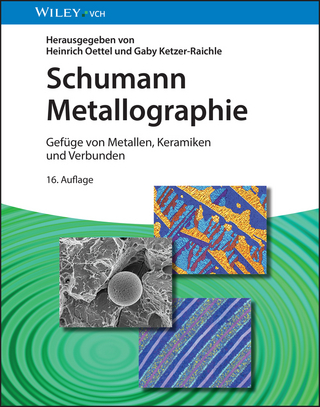
Design for Thermal Stresses
John Wiley & Sons Inc (Verlag)
978-0-470-62769-3 (ISBN)
- Titel z.Zt. nicht lieferbar
- Versandkostenfrei
- Auch auf Rechnung
- Artikel merken
The tools engineers need for effective thermal stress design
Thermal stress concerns arise in many engineering situations, from aerospace structures to nuclear fuel rods to concrete highway slabs on a hot summer day. Having the tools to understand and alleviate these potential stresses is key for engineers in effectively executing a wide range of modern design tasks.
Design for Thermal Stresses provides an accessible and balanced resource geared towards real-world applications. Presenting both the analysis and synthesis needed for accurate design, the book emphasizes key principles, techniques, and approaches for solving thermal stress problems. Moving from basic to advanced topics, chapters cover:
Bars, beams, and trusses from a "strength of materials" perspective
Plates, shells, and thick-walled vessels from a "theory of elasticity" perspective
Thermal buckling in columns, beams, plates, and shells
Written for students and working engineers, this book features numerous sample problems demonstrating concepts at work. In addition, appendices include important SI units, relevant material properties, and mathematical functions such as Bessel and Kelvin functions, as well as characteristics of matrices and determinants required for designing plates and shells. Suitable as either a working reference or an upper-level academic text, Design for Thermal Stresses gives students and professional engineers the information they need to meet today's thermal stress design challenges.
Randall F. Barron is Professor Emeritus of Mechanical Engineering at Louisiana Tech University in Ruston, Louisiana. He received his BS in mechanical engineering from Louisiana Tech University, and his MS and PhD in mechanical engineering from The Ohio State University in Columbus, Ohio. He is the author of three college-level textbooks: Cryogenic Systems, Cryogenic Heat Transfer, and Industrial Noise Control and Acoustics. Brian R. Barron is a lecturer in mathematics and statistics at Louisiana Tech University in Ruston, Louisiana. He received his BS degree in mathematics education from Louisiana Tech University, his MDiv from St. Paul School of Theology in Kansas City, Missouri, and his MS in mathematics and PhD in computational analysis and modeling from Louisiana Tech University.
Preface xi Nomenclature xiii
1 Introduction 1
1.1 Definition of Thermal Stress 1
1.2 Thermal–Mechanical Design 3
1.3 Factor of Safety in Design 4
1.4 Thermal Expansion Coefficient 7
1.5 Young’s Modulus 11
1.6 Poisson’s Ratio 13
1.7 Other Elastic Moduli 14
1.8 Thermal Diffusivity 16
1.9 Thermal Shock Parameters 17
1.10 Historical Note 19
Problems 23
References 25
2 Thermal Stresses in Bars 26
2.1 Stress and Strain 26
2.2 Bar between Two Supports 27
2.3 Bars in Parallel 32
2.4 Bars with Partial Removal of Constraints 35
2.5 Nonuniform Temperature Distribution 43
2.6 Historical Note 52
Problems 53
References 58
3 Thermal Bending 59
3.1 Limits on the Analysis 59
3.2 Stress Relationships 60
3.3 Displacement Relations 64
3.4 General Thermal Bending Relations 65
3.5 Shear Stresses 67
3.6 Beam Bending Examples 69
3.7 Thermal Bowing of Pipes 97
3.8 Historical Note 108
Problems 110
References 117
4 Thermal Stresses in Trusses and Frames 118
4.1 Elastic Energy Method 118
4.2 Unit-Load Method 123
4.3 Trusses with External Constraints 129
4.4 Trusses with Internal Constraints 132
4.5 The Finite Element Method 142
4.6 Elastic Energy in Bending 153
4.7 Pipe Thermal Expansion Loops 158
4.8 Pipe Bends 172
4.9 Elastic Energy in Torsion 178
4.10 Historical Note 185
Problems 186
References 195
5 Basic Equations of Thermoelasticity 197
5.1 Introduction 197
5.2 Strain Relationships 198
5.3 Stress Relationships 203
5.4 Stress–Strain Relations 206
5.5 Temperature Field Equation 208
5.6 Reduction of the Governing Equations 212
5.7 Historical Note 215
Problems 217
References 220
6 Plane Stress 221
6.1 Introduction 221
6.2 Stress Resultants 222
6.3 Circular Plate with a Hot Spot 224
6.4 Two-Dimensional Problems 239
6.5 Plate with a Circular Hole 247
6.6 Historical Note 256
Problems 257
References 262
7 Bending Thermal Stresses in Plates 264
7.1 Introduction 264
7.2 Governing Relations for Bending of Rectangular Plates 265
7.3 Boundary Conditions for Plate Bending 273
7.4 Bending of Simply-Supported Rectangular Plates 277
7.5 Rectangular Plates with Two-Dimensional Temperature Distributions 283
7.6 Axisymmetric Bending of Circular Plates 287
7.7 Axisymmetric Thermal Bending Examples 292
7.8 Circular Plates with a Two-Dimensional Temperature Distribution 305
7.9 Historical Note 310
Problems 312
References 315
8 Thermal Stresses in Shells 317
8.1 Introduction 317
8.2 Cylindrical Shells with Axisymmetric Loading 319
8.3 Cooldown of Ring-Stiffened Cylindrical Vessels 329
8.4 Cylindrical Vessels with Axial Temperature Variation 336
8.5 Short Cylinders 344
8.6 Axisymmetric Loading of Spherical Shells 350
8.7 Approximate Analysis of Spherical Shells under Axisymmetric Loading 357
8.8 Historical Note 371
Problems 373
References 377
9 Thick-Walled Cylinders and Spheres 378
9.1 Introduction 378
9.2 Governing Equations for Plane Strain 379
9.3 Hollow Cylinder with Steady-State Heat Transfer 384
9.4 Solid Cylinder 388
9.5 Thick-Walled Spherical Vessels 397
9.6 Solid Spheres 402
9.7 Historical Note 411
Problems 412
References 415
10 Thermoelastic Stability 416
10.1 Introduction 416
10.2 Thermal Buckling of Columns 416
10.3 General Formulation for Beam Columns 420
10.4 Postbuckling Behavior of Columns 423
10.5 Lateral Thermal Buckling of Beams 426
10.6 Symmetrical Buckling of Circular Plates 432
10.7 Thermal Buckling of Rectangular Plates 437
10.8 Thermal Buckling of Cylindrical Shells 450
10.9 Historical Note 454
Problems 455
References 460
Appendix A Preferred Prefixes in the SI System of Units 461
Appendix B Properties of Materials at 300 K 462
Appendix C Properties of Selected Materials as a Function of Temperature 464
C.1 Properties of 2024-T3 Aluminum 464
C.2 Properties of C1020 Carbon Steel 465
C.3 Properties of 9% Nickel Steel 465
C.4 Properties of 304 Stainless Steel 466
C.5 Properties of Beryllium Copper 466
C.6 Properties of Titanium Alloy 467
C.7 Properties of Teflon 467
References 468
Appendix D Bessel Functions 469
D.1 Introduction 469
D.2 Bessel Functions of the First Kind 470
D.3 Bessel Functions of Noninteger Order 470
D.4 Bessel Functions of the Second Kind 472
D.5 Bessel’s Equation 474
D.6 Recurrence Relationships for Jn(x) and Yn(x) 475
D.7 Asymptotic Relations and Zeros for Jn(x) and Yn(x) 476
D.8 Modified Bessel Functions 477
D.9 Modified Bessel Equation 478
D.10 Recurrence Relations for the Modified Bessel Functions 479
D.11 Asymptotic Relations for In(x) and Kn(x) 480
References 483
Appendix E Kelvin Functions 485
E.1 Introduction 485
E.2 Kelvin Functions 486
E.3 Differential Equation for Kelvin Functions 490
E.4 Recurrence Relationships for the Kelvin Functions 491
E.5 Asymptotic Relations for the Kelvin Functions 492
E.6 Zeros of the Kelvin Functions 493
Appendix F Matrices and Determinants 494
F.1 Determinants 494
F.2 Matrices 499
References 504
Index 505
| Erscheint lt. Verlag | 28.10.2011 |
|---|---|
| Verlagsort | New York |
| Sprache | englisch |
| Maße | 163 x 242 mm |
| Gewicht | 848 g |
| Themenwelt | Naturwissenschaften ► Chemie |
| Technik ► Maschinenbau | |
| ISBN-10 | 0-470-62769-7 / 0470627697 |
| ISBN-13 | 978-0-470-62769-3 / 9780470627693 |
| Zustand | Neuware |
| Informationen gemäß Produktsicherheitsverordnung (GPSR) | |
| Haben Sie eine Frage zum Produkt? |
aus dem Bereich


